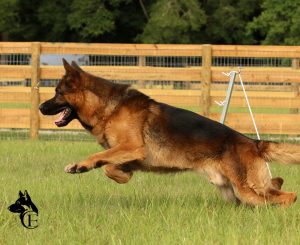Getting a new German Shepherd puppy is an exciting adventure for any new puppy owner. When bringing a new puppy into your home, you’re welcoming a new family member into your lives. German Shepherds make wonderful companions and can easily blend into your family environment. As we all know, when bringing a new puppy into the home, many questions and steps can be taken to make it as easy as possible. Canine Extreme has had 25+ years working with these fantastic dogs, and in this article, you can find some of the most common questions we receive when welcoming a new puppy into the home.
When To Neuter or Spay Your Dog

Early Neutering Poses Health Risks for German Shepherd Dogs, Study Finds
By Trina Wood on May 26, 2016 in Human & Animal Health
Renowned for their intelligence, obedience and loyalty, German shepherd dogs are often the preferred breed for police and military work, as well as popular service dogs and family pets. But as most handlers, breeders and veterinarians are aware, joint disorders are a big concern in these animals.
A new study in the journal Veterinary Medicine and Science finds that neutering or spaying these dogs before 1 year of age triples the risk of one or more joint disorders — particularly for cranial cruciate ligament, or CCL, tears.
“Debilitating joint disorders of hip dysplasia, CCL and elbow dysplasia can shorten a dog’s useful working life and impact its role as a family member,” said lead investigator Benjamin Hart, a distinguished professor emeritus in the UC Davis School of Veterinary Medicine. “Simply delaying the spay/neuter until the dog is a year old can markedly reduce the chance of a joint disorder.”
Dog owners in the United States typically choose to spay or neuter their dogs prior to 6 months of age, in large part to prevent pet overpopulation or hoping to avoid unwanted behaviors. In Europe, however, neutering is generally avoided by owners and trainers and not promoted by animal health authorities, Hart said.
During the past decade, some studies have indicated that spaying or neutering can have several adverse health effects for certain dog breeds. For example, a 2014 study published in PLoS ONE and also led by Hart, examined the health records of over 1,000 golden retrievers and found a surprising fourfold increase in one or more joint disorders associated with spay or neuter before 1 year of age. In the same paper, joint disorders in Labrador retrievers were found to be increased by just twofold in dogs spayed or neutered in the first year.
For this current study, researchers examined veterinary hospital records over a 14.5-year period on 1,170 intact and neutered (including spayed) German shepherd dogs for joint disorders and cancers previously associated with neutering. The diseases were followed through 8 years of age, with the exception of mammary cancer in females, which was followed through 11 years.
The dogs were classified as intact (not neutered), neutered before 6 months, neutered between 6 to 11 months, or neutered between 12 to 23 months and 2 to 8 years. Joint disorders and cancers are of particular interest because neutering removes male and female sex hormones that play key roles in important body processes such as closure of bone growth plates.
Seven percent of intact males were diagnosed with one or more joint disorders, compared to 21 percent of males neutered prior to a year of age.
In intact females, 5 percent were diagnosed with one or more joint disorders, while in females neutered prior to 1 year of age this measure was significantly increased to 16 percent.
Mammary cancer was diagnosed in 4 percent of intact females compared with less than 1 percent in females neutered before 1 year of age. (The occurrence of the other cancers followed through 8 years of age was not higher in the neutered than in the intact dogs.)
Urinary incontinence, not diagnosed in intact females, was diagnosed in 7 percent of females neutered before 1 year of age.
“In addition to dogs suffering pain from joint disorders, the condition may also disqualify the dog as a working partner in military and police work,” Hart said. “We hope these findings provide evidence-based guidelines for deciding the right age to neuter a puppy to reduce the risk of one or more joint disorders.”
Other researchers on this UC Davis study were: Lynette Hart and Abigail Thigpen, School of Veterinary Medicine; and Neil Willits, Department of Statistics.
The research was supported by the Canine Health Foundation and donors to the Center for Companion Animal Health.
Media contact(s)
Benjamin Hart, School of Veterinary Medicine, 530-219-3298, blhart@ucdavis.edu
Trina Wood, School of Veterinary Medicine Dean’s Office, 530-752-5257, tjwood@ucdavis.edu
Pat Bailey, News and Media Relations, 530-219-9640, pjbailey@ucdavis.edu
More Articles
Different Types of German Shepherd Colors and Coats
German Shepherds are marvelous dogs who boast many features that appeal to our eyes. One of their main features are the colors and coat varieties that they can have. In this article, you will find a brief breakdown of some of the colors and coats of a German Shepherd.
Staying Cool In The Heat
Nothing says summer like sand between the paws, ice water by the pool, and walks in the sunshine. Summer is a time full of fun, adventures, and outdoor activities. While we all know how “cool” our dogs like to look over summer, like Kongo does while rocking his summer shades by the pool, it’s essential to remember to keep our dogs “cool” from the heat as well. Rest assured, while overheating and heatstroke are severe, with a bit of education and awareness of ways to keep cool, you and your pet can continue to enjoy all the fun activities that summer has to offer.